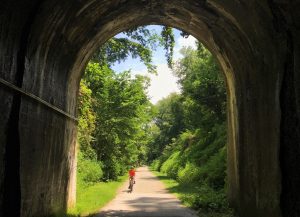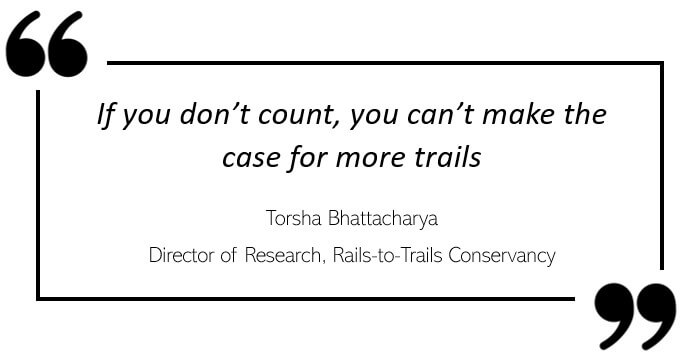Note: This article was originally published in the Fall 2018 edition of American Trails.
Rails-to-Trails Conservancy (RTC) is a non-profit organization dedicated to creating a nationwide network of trails from former rail lines and connecting corridors to build healthier places for healthier people. In Pennsylvania, RTC is taking an innovative approach to managing their network of 180 rail trails: through data collection on 1,916 miles of the nation’s premiere recreation infrastructure. By gaining an understanding of how and when trails are used, RTC are able to capture seasonal trends, measure trail popularity, determine the impact of weather and assess changes in trail use due to construction and maintenance.

Until recently, user count data was collected manually through an annual volunteer effort. In 2017, however, RTC Pennsylvania took their count program to the next level by rolling out 17 automated Eco-Counters in all four corners of the state. While manual count collection provides a snapshot of data at a particular moment in time, automated counters gather data 24/7, providing an annual profile of trail usage.
Eco-Counter’s MULTI counter differentiates between pedestrians and cyclists and is housed in a discreet post that blends into the surrounding natural environment. This system makes it easy to access data, as data is transmitted wirelessly through cellular networks to an intuitive, free online data analysis platform.

Image source: Milo Bateman, Rails-to-Trails Conservancy
Across the state, the automated counters are installed on trails in a variety of rural, semi-urban and urban areas. Data from the counters provide an understanding of just how many people are enjoying the RTC network and how trails are used – such as for weekend recreation or weekday commuting. On the Panhandle Trail just outside of Pittsburgh, for example, trail usage is 50% higher during the weekend compared to mid-week, informing trail managers that the trail is used predominantly for leisure and recreation. Overall, 800,000 people have been counted on the RTC trails in PA so far this year (Jan-Sep), with northeastern PA’s Lackawanna Heritage Trail having the greatest number of visitors counted at over 85,000 – that’s nearly 10,000 trail users counted per month!

According to Rails-to-Trails Conservancy, count data is an essential tool to acquire funding for future trails. Earlier this year, for example, RTC PA applied for a Transportation Alternative Program (TAP) grant with the federal government; count data was extensively included in the application as a means to justify the extension of a trail and to fill in gaps within the network. Combining the count data with other data sources, such as health, environmental or economic indicators, this rich data source serves as a key tool to demonstrate the quantitative benefit of trails to local communities and the surrounding area. Using Eco-Counter’s public web page service, Rails-to-Trails have gone one step further and made daily count data publicly available, providing individuals, research institutions and advocacy organisations unprecedented access to statewide trail usage data.

Image source: Milo Bateman, Rails-to-Trails Conservancy
Harnessing technology for trail development, RTC in Pennsylvania is a leading example of 21st century trail management. As this program–and others across the country–continues to grow, data collection will play an increasingly vital role in the future of trails.

Image source: Milo Bateman, Rails-to-Trails Conservancy
Cover image source: Milo Bateman, Rails-to-Trails Conservancy







Il n'y a pas encore de commentaires